As promised, I am going to share my method for home stoving tobaccos that I find brings the best results. The blend that I’ve had the greatest success with (ie. the one that I like best) is Peter Stokkebye Luxury Twist Flake, so that’s what I’ll be illustrating. Let’s go make some magic.....
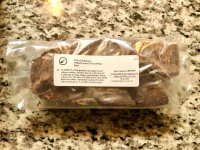
Today I’ll be stoving 1 lb. of PS LTF and I’ll be doing this in two 16 oz. Mason jars, the type with the 2 part lids. An 16 oz. Mason jar will loosely (comfortably) hold 8 oz. of flake tobacco. I feel that allowing space for the heat to convect around the tobacco is a very important part of process. So I load the jars with the flakes standing on edge, like this:
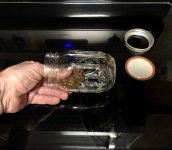
This is what the jar looks like after it has been fully loaded:
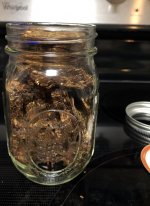
As you can see, I do lay the top flakes flat to take up the remaining space in the jar, but the rest of the jar has the flakes standing on edge. I have no evidence to the contrary that laying all of the flakes flat won’t produce the same results. Standing the flakes on edge is merely “gut instinct“ to me. After the jar has been loaded, it must be sealed to help retain the tobaccos moisture. I do this with aluminum foil:
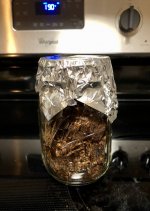
Once the aluminum foil is in place I lock it down with the retaining ring that comes with the Mason Jar:
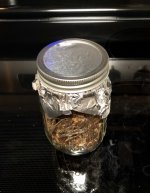
A word of caution: I am never tempted to use the lid that comes with the Mason jar in order to save a step. Using the lid that comes with the Mason jar will produce an airtight seal which will not allow any pressure to escape and this may cause the jar to shatter. Aluminum foil retains the moisture while allowing any pressure to escape, so I always use aluminum foil.
While I am loading the Mason jars, I allow my home stove (oven) to preheat to 190 degrees.

I have read many blog posts on the subject of how to home stove tobacco, and 190 degrees seemed to be the most popular consensus (and my good results confirm this).
I place the prepared jar as close to the center of the oven as possible:
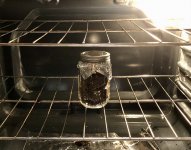
Close the oven door, set the timer for 2 hours and sit back and watch the fermentation (with a pipe in hand, of course):

When the timer goes off (this part is critical for time and safeties sake) I have both a heavy duty oven mitt handy as well as a thick dish towel. 190 degrees may not sound like much, but it will blister fingers in a heartbeat. I take the Mason Jar out of the oven (using my oven mitt and dish towel) and place it on a heatproof surface (the top of my stove is glass so this works best).
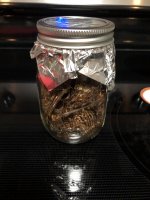
Here is where time is of the essence. As quickly and safely as I can, I remove the retaining ring from the jar (using my oven mitt and dish towel);
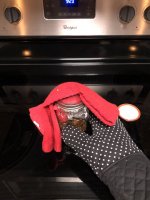
cap the jar with the the original lid and replace the retaining ring tightening it firmly:
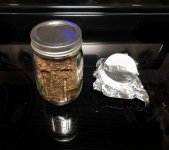
Time is truly critical when performing this process because as the tobacco cools, it releases condensation, and this condensation must be trapped in order for the process to be a success. Here is what it looks like just a few short minutes after lidding the still hot Mason Jar:
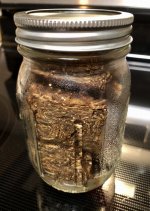
See the condensation clinging to the walls of the jar? It is my belief that if you loose the condensation, you loose the tobacco. Here is another view:
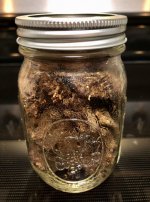
The condensation will absorb back into the tobacco within the hour and in the process, the Mason jar will draw a vacuum seal. The hard part is now over and the harder part is yet to come: I MUST allow the tobacco to rest in a dark location for two weeks! Yes, this is the hardest part. But after two weeks I will be greeted by the most wonderful sounding WHOOSH as I pry the lid off my very own home stoved creation. This is followed by a tin note of rich chocolate and caramel aromas that do translate to the smoke (for me). The overall results: PS LTF takes on a deep, rich, luxurious chocolate-like flavor that is complex, full bodied and satisfying. To me, it is an after dinner smoke; one that is sweet but not in any cloying way.
I hope that this post has been both informative and intriguing? I have stoved other tobaccos, but the ones that give me the best results are PS Luxury Twist Flake and PS Bullseye Flake (with LTF being my favorite). ENJOY!
*Disclaimer: No One Should Try This Themselves. If you choose to do so, you do so at your own risk. This post is for educational purposes only.

Today I’ll be stoving 1 lb. of PS LTF and I’ll be doing this in two 16 oz. Mason jars, the type with the 2 part lids. An 16 oz. Mason jar will loosely (comfortably) hold 8 oz. of flake tobacco. I feel that allowing space for the heat to convect around the tobacco is a very important part of process. So I load the jars with the flakes standing on edge, like this:

This is what the jar looks like after it has been fully loaded:

As you can see, I do lay the top flakes flat to take up the remaining space in the jar, but the rest of the jar has the flakes standing on edge. I have no evidence to the contrary that laying all of the flakes flat won’t produce the same results. Standing the flakes on edge is merely “gut instinct“ to me. After the jar has been loaded, it must be sealed to help retain the tobaccos moisture. I do this with aluminum foil:

Once the aluminum foil is in place I lock it down with the retaining ring that comes with the Mason Jar:

A word of caution: I am never tempted to use the lid that comes with the Mason jar in order to save a step. Using the lid that comes with the Mason jar will produce an airtight seal which will not allow any pressure to escape and this may cause the jar to shatter. Aluminum foil retains the moisture while allowing any pressure to escape, so I always use aluminum foil.
While I am loading the Mason jars, I allow my home stove (oven) to preheat to 190 degrees.

I have read many blog posts on the subject of how to home stove tobacco, and 190 degrees seemed to be the most popular consensus (and my good results confirm this).
I place the prepared jar as close to the center of the oven as possible:

Close the oven door, set the timer for 2 hours and sit back and watch the fermentation (with a pipe in hand, of course):

When the timer goes off (this part is critical for time and safeties sake) I have both a heavy duty oven mitt handy as well as a thick dish towel. 190 degrees may not sound like much, but it will blister fingers in a heartbeat. I take the Mason Jar out of the oven (using my oven mitt and dish towel) and place it on a heatproof surface (the top of my stove is glass so this works best).

Here is where time is of the essence. As quickly and safely as I can, I remove the retaining ring from the jar (using my oven mitt and dish towel);

cap the jar with the the original lid and replace the retaining ring tightening it firmly:

Time is truly critical when performing this process because as the tobacco cools, it releases condensation, and this condensation must be trapped in order for the process to be a success. Here is what it looks like just a few short minutes after lidding the still hot Mason Jar:

See the condensation clinging to the walls of the jar? It is my belief that if you loose the condensation, you loose the tobacco. Here is another view:

The condensation will absorb back into the tobacco within the hour and in the process, the Mason jar will draw a vacuum seal. The hard part is now over and the harder part is yet to come: I MUST allow the tobacco to rest in a dark location for two weeks! Yes, this is the hardest part. But after two weeks I will be greeted by the most wonderful sounding WHOOSH as I pry the lid off my very own home stoved creation. This is followed by a tin note of rich chocolate and caramel aromas that do translate to the smoke (for me). The overall results: PS LTF takes on a deep, rich, luxurious chocolate-like flavor that is complex, full bodied and satisfying. To me, it is an after dinner smoke; one that is sweet but not in any cloying way.
I hope that this post has been both informative and intriguing? I have stoved other tobaccos, but the ones that give me the best results are PS Luxury Twist Flake and PS Bullseye Flake (with LTF being my favorite). ENJOY!
*Disclaimer: No One Should Try This Themselves. If you choose to do so, you do so at your own risk. This post is for educational purposes only.
Last edited:






